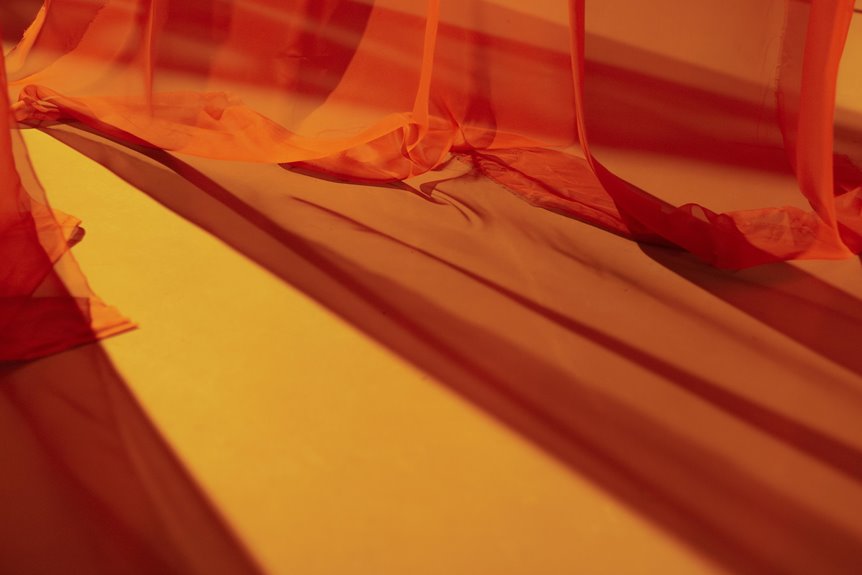Imagine waking up refreshed after a deep sleep, thanks to the cozy ambiance created by your new linen blackout curtains. They not only block out unwanted light but also add a touch of elegance to your space. But did you know there are several other natural fabrics that can offer similar benefits? Let’s explore the best options for achieving that perfect balance between style and functionality in your home.
Table of Contents
Key Takeaways
- Linen: Offers excellent light-blocking capabilities with breathability and durability, making it ideal for year-round use in blackout curtains.
- Cotton: Versatile and available in various designs, it effectively blocks light while providing temperature regulation and easy maintenance.
- Hemp: An eco-friendly option that combines excellent light-blocking efficiency with a unique texture, enhancing the elegance of home décor.
- Bamboo: Renewable and breathable, bamboo has natural insulating properties that help in blocking light while promoting sustainability.
- Wool: Provides exceptional thermal regulation and light-blocking abilities, making it a luxurious choice for blackout curtains.
Linen: A Sustainable Choice for Blackout Curtains
When you’re looking for an eco-friendly option for blackout curtains, linen stands out as a sustainable choice. This natural fabric comes from the flax plant, requiring minimal water and pesticides during cultivation.
Its durability means you won’t have to replace your curtains frequently, reducing waste. Linen also boasts excellent insulating properties, helping to regulate temperature in your home, which can save on energy costs.
Additionally, its natural fibers allow for breathability, ensuring that your space remains comfortable year-round.
You’ll appreciate the texture and elegance linen brings, creating a cozy atmosphere while blocking out unwanted light.
With linen, you’re not just making a stylish choice; you’re also supporting sustainable practices, making it a win-win for both you and the environment.
Cotton: Versatile and Breathable Fabric
Cotton is a fantastic choice for blackout curtains, especially if you want a fabric that’s both versatile and breathable. This natural fiber adapts well to various décor styles, from modern to rustic. You can easily find cotton blackout curtains in an array of colors and patterns, allowing you to express your personal style while blocking out light.
Cotton’s breathability helps regulate temperature, ensuring your space remains comfortable year-round. Additionally, it’s easy to care for, making maintenance a breeze. You won’t have to worry about frequent washing, as cotton is durable and resistant to wear.
Hemp: Eco-Friendly and Durable Option
If you’re looking for an eco-friendly and durable curtain option, hemp might be your best bet.
This sustainable fabric not only grows quickly but also offers excellent light-blocking efficiency.
You’ll appreciate how it combines environmental responsibility with practicality in your home.
Sustainability and Growth
As sustainability becomes increasingly important, hemp emerges as a standout option for blackout curtains. This versatile plant grows rapidly, requiring minimal water and no pesticides, making it an eco-friendly choice. By opting for hemp, you’re supporting sustainable agriculture that reduces environmental impact.
Additionally, hemp’s durability means your curtains will last longer, reducing the frequency of replacements and waste. Choosing hemp not only promotes sustainability but also contributes to a growing market focused on eco-conscious products.
You’ll be part of a movement towards responsible living, aligning your home decor choices with your values. As more consumers seek out green options, hemp’s popularity is set to rise, making it a smart choice for both your home and the planet.
Light-Blocking Efficiency
How effectively can hemp blackout curtains block out light? Hemp curtains offer impressive light-blocking efficiency, thanks to their dense weave and natural fibers. They can greatly reduce the amount of sunlight entering your space, creating a cozy, dark environment ideal for sleeping or relaxing.
Unlike synthetic options, hemp is eco-friendly and durable, providing long-lasting performance while maintaining aesthetic appeal. When you choose hemp, you’re not just enhancing your home’s comfort; you’re also making a sustainable choice.
These curtains’re less likely to fade over time, ensuring they keep their shape and functionality. Plus, their unique texture adds a touch of elegance to any room. So, if you’re looking for effective light-blocking curtains, hemp’s a fantastic option to think about.
The Light-Blocking Effectiveness of Natural Fibers
When considering natural fibers for blackout curtains, you might wonder how they stack up against synthetic options regarding light-blocking effectiveness.
The density and weaving techniques play a vital role in determining how well these fabrics can keep light at bay.
Additionally, combining natural fibers with blackout linings can enhance their performance, giving you the best of both worlds.
Natural vs. Synthetic Effectiveness
While synthetic fabrics often dominate the market for blackout curtains, natural fibers can also offer impressive light-blocking capabilities. You might be surprised to learn that materials like cotton, linen, and hemp can effectively reduce light, making your space more comfortable.
These fabrics often have a unique texture and aesthetic that synthetic options can’t replicate, adding warmth to your decor. Natural fibers tend to breathe better, which can help regulate temperature in your room.
Although synthetic options might provide a more complete blackout effect, many people find natural fabrics to be sufficient for their needs, especially those seeking an eco-friendly choice. Ultimately, balancing effectiveness with personal preference will guide your decision between natural and synthetic curtains.
Density and Weaving Techniques
Although natural fibers like cotton and linen may not seem as effective at blocking light as synthetic materials, their density and weaving techniques play an essential role in their ability to create a comfortable environment.
Thicker fabrics with tighter weaves can considerably reduce light penetration, making them more effective than you might think. For instance, a densely woven cotton can block out light better than a loose-weave linen.
Additionally, the yarn’s thickness contributes to the overall opacity of the curtain. You’ll find that selecting a heavier fabric with a tight weave enhances its light-blocking capabilities.
Combination With Blackout Linings
Combining natural fibers with blackout linings can greatly enhance your curtains’ light-blocking effectiveness. Natural fabrics like cotton or linen are breathable and add an appealing aesthetic, but they often let in unwanted light.
By adding a blackout lining, you create a formidable barrier against sunlight and UV rays, ensuring your space remains cozy and private. This combination not only improves light control but also enhances energy efficiency by regulating indoor temperatures.
Plus, you can choose linings that complement your decor, allowing you to maintain style without sacrificing function. So, if you want the best of both worlds, consider investing in curtains that blend the beauty of natural fibers with the practicality of blackout linings for ultimate comfort.
Comparing Natural Fabrics to Synthetic Alternatives
When it comes to choosing blackout fabrics for curtains, you’ll find a significant difference between natural and synthetic options.
Natural fabrics like cotton and linen offer breathability and a cozy aesthetic, making your space feel warm and inviting. They’re often more environmentally friendly, as they’re biodegradable and produced without harsh chemicals.
On the other hand, synthetic fabrics such as polyester and nylon typically excel in durability and affordability. They can also provide enhanced light-blocking capabilities, which is a key factor for blackout curtains. However, they might lack the softness and organic feel that many prefer in a home setting.
Ultimately, your choice will depend on your priorities: aesthetics, environmental impact, or performance. Consider what matters most to you before making a decision.
Maintenance Tips for Natural Blackout Fabrics
Natural blackout fabrics can enhance your home’s aesthetic, but they do require specific care to maintain their beauty and functionality.
Natural blackout fabrics elevate your home’s style, but they need careful maintenance to preserve their appeal and effectiveness.
Start by vacuuming your curtains regularly to remove dust and prevent buildup. When it’s time for a deeper clean, check the care label; many natural fabrics are machine washable on a gentle cycle, but some may need hand washing or dry cleaning.
Avoid bleach and harsh detergents, as they can damage the fibers. If your curtains fade, consider rotating them occasionally to guarantee even exposure to sunlight.
For stubborn stains, treat them promptly with a mild soap solution. Finally, hang curtains back up while they’re slightly damp to help minimize wrinkles and maintain that fresh look.
Eco-Certifications to Look for in Blackout Curtains
How can you guarantee your blackout curtains aren’t just stylish but also environmentally friendly?
Look for eco-certifications that confirm sustainable practices. The Global Organic Textile Standard (GOTS) certifies fabrics made from organic materials, confirming they’re free from harmful chemicals.
Oeko-Tex Standard 100 is another important certification; it guarantees that your curtains are tested for toxic substances, making them safe for your home.
If you’re concerned about the environmental impact, check for the Forest Stewardship Council (FSC) label, which confirms the fabric comes from responsibly managed forests.
By choosing curtains with these certifications, you’re not only enhancing your space but also contributing to a healthier planet.
Frequently Asked Questions
Are Natural Blackout Fabrics More Expensive Than Synthetic Options?
You might find that natural blackout fabrics come with a slightly higher price tag than their synthetic counterparts. However, investing in quality often means better durability and aesthetics, making it a worthwhile choice in the long run.
How Do I Choose the Right Color for Blackout Curtains?
When choosing a color for your blackout curtains, consider your room’s existing palette, desired mood, and natural light. Darker shades can create a cozy atmosphere, while lighter tones may enhance brightness and openness.
Can I Machine Wash Natural Blackout Fabrics?
You can comfortably choose to clean cotton or linen blackout fabrics in the machine. Just make sure to select a gentle cycle and cold water. Avoid aggressive detergents, and your curtains should stay stunning and safe!
Do Natural Fabrics Fade in Sunlight Over Time?
Yes, natural fabrics can fade in sunlight over time. To minimize fading, you should rotate your curtains regularly and use window treatments that reduce direct sunlight exposure, helping preserve their color and integrity longer.
Are There Fire-Retardant Options for Natural Blackout Curtains?
Yes, there are fire-retardant options for natural blackout curtains. You can find fabrics treated with fire retardants or opt for inherently flame-resistant materials. Always check labels to guarantee they meet safety standards for your needs.
- A Look at Stitch-Bonded Nonwoven Fabrics - July 11, 2025
- What Is Thermal Bonded Nonwoven Fabric? - July 11, 2025
- The Impact of Fiber Type on Nonwoven Fabric Properties - July 11, 2025




